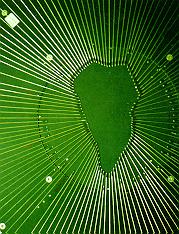Instruments and Detectors
THE TELESCOPES possess a wide range
of instruments to cater for the requirements of the scientists. The ING
has a strong instrument development programme to keep abreast of the latest
technological developments. Observations can be performed not only in visible
light but also in ultra-violet and infra-red, and astronomers can select
which part of the spectrum they want to use to take images of the sky.
The light from stars, galaxies or any other night-time celestial object
can be analysed by spectrographs - instruments that separate the light
according to wavelength. Until recently astronomers could only study the
spectrum of one object at a time, but developments in optical fibre technology
have made it possible to pick up the light of many objects at the same
time.
| The collection of optical fibres that
make up Autofib. Using this instrument on the WHT, astronomers can
obtain spectra of more than one hundred objects over a large field of view.
The fibres can be positioned to an accuracy of half the thickness of a
human hair. Here they trace an outline of La Palma. |
 |
All instruments are fitted with state-of-the-art
detectors, which record the spectra or images received. Current CCD (Charge
Coupled Device) detector technology provides nearly perfect solid-state,
digital detectors that are now widely used in astronomy and have replaced
other light sensitive devices such as photographic plates.
Despite the excellent climatic
conditions on La Palma, the starlight is still distorted by the Earth's
atmosphere. Because of this, the full potential of the telescope optics
cannot normally be achieved. However new optical methods have recently
been developed that allow these atmospheric distortions to be corrected.
The application of these techniques, adaptive optics, is the major development
on the WHT over the next few years. This will allow astronomers to study
objects in unprecedented detail.
| The primary mirror of the WHT being
replaced after aluminizing. The mirror is made out of a glass which is
not affected by temperature changes. It is coated with aluminium to give
a reflectivity of 90-95 per cent. The mirror is recoated each autumn. As
the telescope moves across the sky, a mirror support system continuously
measures the forces on the mirror and corrects for them, in order that
the shape of the mirror remains constant. |
 |
Except for occasional photography, nearly
all astronomers' work is done electronically, and the astronomers rarely,
if ever, look directly through the telescope. Telescopes, instruments and
detectors are controlled by local microprocessors and control systems,
with overall control from various system computers.
|

